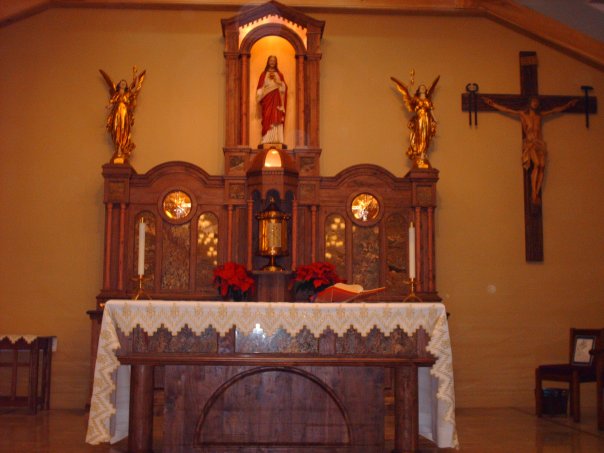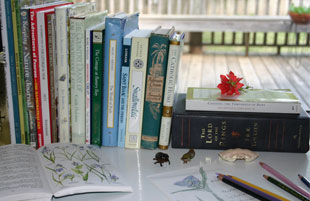| Author | |
Cay Gibson
Forum All-Star


Joined: July 16 2005
Location: Louisiana
Online Status: Offline
Posts: 5193
|
| Posted: June 03 2009 at 9:24am | IP Logged
|
 |
|
Our church was recently remodeled...completely.
Here is a picture of the new altar:

My grandmother, due to a number of health/growing older issues, has not been back to mass since the remodeling.
There are a number of issues, legitimate even, but the one excuse she gives is that the altar is brown and she has never in her life seen a brown altar. She said her altars were always white and that's how it's supposed to be and she doesn't like the change.
I can understand an elderly person not liking change but it got me curious. My question is this: are altar "supposed" to be white or does it matter? Is there a "traditional" explanation for a white altar or does it matter?
I'm just curious.
__________________
Cay Gibson
"There are 49 states, then there is Louisiana." ~ Chef Emeril
wife to Mark '86
mom to 5
Cajun Cottage Under the Oaks
|
| Back to Top |



|
| |
sarahb
Forum Pro

Joined: April 27 2008
Online Status: Offline
Posts: 182
|
| Posted: June 03 2009 at 10:19am | IP Logged
|
 |
|
I have never been to a church with a white altar. An altar is a table and tables tend to be wooden, and wood tends to be brown. BTW I think your altar there is particularly beautiful.
|
| Back to Top |


|
| |
CrunchyMom
Forum Moderator


Joined: Sept 03 2007
Online Status: Offline
Posts: 6385
|
| Posted: June 03 2009 at 10:32am | IP Logged
|
 |
|
Hmmmm, I think that the altar cloth should be white, as in the picture, and a lot of altars are made of marble which is white--and probably there is significance in their being white--but I don't think there is a requirement. Priests say mass in many different settings that don't have a special white table.
I do remember there being a specification that, if saying mass in a home or other such setting, it is ideal that the table be "special" and not used for regular, every day activities. So, you probably wouldn't want to just use your dining table, for instance. Not sure if that is a requirement or merely a preference.
__________________
Lindsay
Five Boys(6/04) (6/06) (9/08)(3/11),(7/13), and 1 girl (5/16)
My Symphony
[URL=http://mysymphonygarden.blogspot.com/]Lost in the Cosmos[/UR
|
| Back to Top |


|
| |
MaryM
Board Moderator


Joined: Feb 11 2005
Location: Colorado
Online Status: Offline
Posts: 13104
|
| Posted: June 03 2009 at 10:37am | IP Logged
|
 |
|
I'll take a stab at this. Traditionally altars have been made of stone, though in the US wooden ones are allowed. Generally stone (usually marble) is of a lighter color (white, cream, gray) so it would be easy to see an associaton of white for altars. So in most older churches that were solidly built, well established (not talking about pioneer and mission churches where the materials would have more likely been wood) the altars were always stone. Probably what your grandmother remembers.
I've included the section from the GIRM (General Instruction of the Roman Missal) that discusses the requirements for altars.
From the General Instruction of the Roman Missal (GIRM): wrote:
“The altar on which the Sacrifice of the Cross is made present under sacramental signs is also the table of the Lord to which the People of God is called together to participate in the Mass, as well as the center of the thanksgiving that is accomplished through the Eucharist.” ( # 296)
The altar is traditionally made of stone, calling to mind Christ as the living cornerstone of the Catholic faith:
“So then you are no longer strangers and sojourners, but you are fellow citizens with the saints and members of the household of God,
built upon the foundation of the apostles and prophets, Christ Jesus himself being the cornerstone” (Ephesians 2:19-20)
“Come to him, to that living stone, rejected by men but in God's sight chosen and precious; and like living stones be yourselves built into a spiritual house, to be a holy priesthood, to offer spiritual sacrifices acceptable to God through Jesus Christ. For it stands in scripture: "Behold, I am laying in Zion a stone, a cornerstone chosen and
precious, and he who believes in him will not be put to shame.” 1 Peter 2:4-6)
However, though the traditional stone is preferred, the altar in churches in the United States may be made of a durable, solid wood:
It is appropriate to have a fixed altar in every church, since it more clearly and permanently signifies Christ Jesus, the living stone. In other places set aside for sacred celebrations, the altar may be movable.
In keeping with the Church's traditional practice and the altar's symbolism, the table of a fixed altar is to be of stone and indeed of natural stone. In the dioceses of the United States of America, however, wood which is worthy, solid, and well-crafted may be used, provided that the altar is structurally immobile. The supports or base for upholding the table, however, may be made of any sort of material, provided it is worthy and solid. (GIRM, #298,301) |
|
|
And this is a history from a Catholic supply website
Quote:
History of the Altar
The Christian altar is one of the earliest elements of the liturgy. In the first years when Christianity was illegal, the Eucharist was typically celebrated in the homes of the faithful. The altar could have been the dinner table in the home or the wooden chest in which a bishop would carry needed materials for celebrating the Eucharist from place to place.
Fixed altars made of stone became prevalent when Constantine established that Christianity would no longer be illegal and more churches were erected for the purpose of celebrating the Mass. Wood altars were still used for a time, as were metal altars. However, with time preference was given to stone because it lasted better than wood and metal and was not subject to the decay those materials were. In 517, the provincial council of Epeaune in France decreed that the altar was to be made of stone. However, this was a provincial decree only and wooden altars were not uncommon even through the 9th century; after that century wooden altars were not often seen in the Latin churches. Wooden altars remain common in the Greek Church to this day.
Early altars were not placed against walls, but set apart so that the bishop or priests would stand facing the people. Around the 5th century, it became popular for the altar to face the East or be set against a wall. The priest would celebrate the Mass facing east, and the people would face East with him, symbolic of looking toward Christ as the Dawn. In the Middle Ages, the altar ceased to resemble the table of the early Church. Altars of Medieval times began to be designed very ornately, and were adorned with statues, relics, and paintings, and of course the tabernacle. In the mid-20th century, in many countries, the altar was moved away from the wall again, with the priest celebrating the Mass facing the people.
Catholic altars today are often stone, though as mentioned above, an altar made of quality wood is permitted. In most churches in the U.S. the altar is set apart from the wall, so that the celebrant faces the congregation. The current regulations on the altar in the United States can be read in the General Instruction on the Roman Missal, chapter 5.
This article used information from The Catholic Encyclopedia, Catholic customs and Traditions, How to Read a Church, and the General Instruction on the Roman Missal.) |
|
|
Note: looks like I cross posted with Lindsay.
__________________
Mary M. in Denver
Our Domestic Church
|
| Back to Top |



|
| |
Mary K
Forum All-Star

Joined: May 14 2005
Online Status: Offline
Posts: 945
|
| Posted: June 03 2009 at 10:46am | IP Logged
|
 |
|
it is beautiful. according to catholic answers, the altar should be made of stone, but since that is unlikely nowadays, wood (any color) is allowed.
|
| Back to Top |


|
| |
Cay Gibson
Forum All-Star


Joined: July 16 2005
Location: Louisiana
Online Status: Offline
Posts: 5193
|
| Posted: June 03 2009 at 11:28am | IP Logged
|
 |
|
Thank you, ladies.
I knew you'd come through for me. 
Lindsay, we did have a marble altar there before and that's probably what she's thinking of from her childhood days as well. She's been a parishioner of this church since the 1950's.
One of our parishioners does beautiful wood work and did all the work in our church and adoration chapel...including the altar.
Mary, thank you for the references. That's what I was looking for. 
__________________
Cay Gibson
"There are 49 states, then there is Louisiana." ~ Chef Emeril
wife to Mark '86
mom to 5
Cajun Cottage Under the Oaks
|
| Back to Top |



|
| |
Mary G
Forum All-Star


Joined: Feb 07 2005
Location: Virginia
Online Status: Offline
Posts: 5790
|
| Posted: June 03 2009 at 11:31am | IP Logged
|
 |
|
Cay .... what your grandmother is probably remembering is the full cover on the altar -- all sides all the way to the floor so she's right, it was white. I'm not sure when they switched to the partial cloth ...
Hugs and blessings to one and all ....
__________________
MaryG
3 boys (22, 12, 8)2 girls (20, 11)
my website that combines my schooling, hand-knits work, writing and everything else in one spot!
|
| Back to Top |



|
| |
|
|


 Topic: White or Brown Altars?
Topic: White or Brown Altars?









